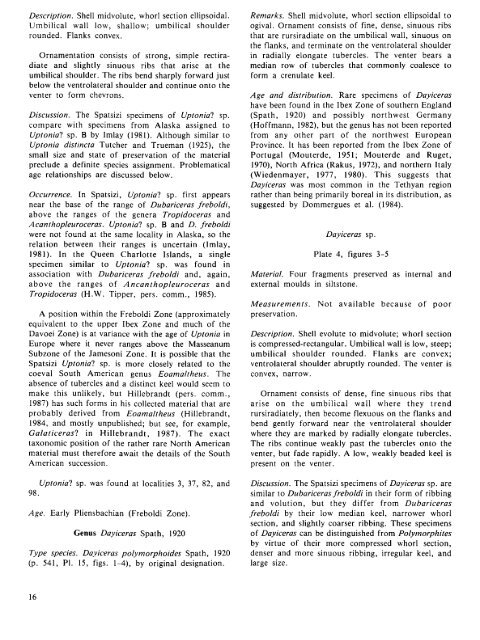PLIENSBACHIAN (LOWER JURASSIC) BIOSTRATIGRAPHY AND ...
PLIENSBACHIAN (LOWER JURASSIC) BIOSTRATIGRAPHY AND ...
PLIENSBACHIAN (LOWER JURASSIC) BIOSTRATIGRAPHY AND ...
Create successful ePaper yourself
Turn your PDF publications into a flip-book with our unique Google optimized e-Paper software.
D escription. Shell midvolute, whorl section ellipsoidal.<br />
Umbilical wall low, shallow; umbilical shoulder<br />
rounded. Flanks convex.<br />
Ornamentation consists of strong, simple rectira-<br />
diate and slightly sinuous ribs that arise at the<br />
umbilical shoulder. The ribs bend sharply forward just<br />
below the ventrolateral shoulder and continue onto the<br />
venter to form chevrons.<br />
Discussion. The Spatsizi specimens of U ptonial sp.<br />
compare with specimens from Alaska assigned to<br />
U ptonial sp. B by Imlay (1981). Although similar to<br />
Uptonia distinct a Tutcher and Trueman (1925), the<br />
small size and state of preservation of the material<br />
preclude a definite species assignment. Problematical<br />
age relationships are discussed below.<br />
Occurrence. In Spatsizi, U ptonial sp. first appears<br />
near the base of the range of Dubariceras freboldi,<br />
above the ranges of the genera Tropidoceras and<br />
Acanthopleuroceras. U ptonial sp. B and D. freboldi<br />
were not found at the same locality in Alaska, so the<br />
relation between their ranges is uncertain (Imlay,<br />
1981). In the Queen Charlotte Islands, a single<br />
specimen similar to U pto n ia l sp. was found in<br />
association with D ubariceras fre b o ld i and, again,<br />
above the ranges of A n c a n th o p le u ro c e ra s and<br />
Tropidoceras (H.W. Tipper, pers. comm., 1985).<br />
A position within the Freboldi Zone (approximately<br />
equivalent to the upper Ibex Zone and much of the<br />
Davoei Zone) is at variance with the age of Uptonia in<br />
Europe where it never ranges above the Masseanum<br />
Subzone of the Jamesoni Zone. It is possible that the<br />
Spatsizi U ptonial sp. is more closely related to the<br />
coeval South American genus E oam aitheus. The<br />
absence of tubercles and a distinct keel would seem to<br />
make this unlikely, but Hillebrandt (pers. comm.,<br />
1987) has such forms in his collected material that are<br />
probably derived from E oam aitheus (Hillebrandt,<br />
1984, and mostly unpublished; but see, for example,<br />
G a la tic e ra sl in H illebrandt, 1987). The exact<br />
taxonomic position of the rather rare North American<br />
material must therefore await the details of the South<br />
American succession.<br />
U ptonial sp. was found at localities 3, 37, 82, and<br />
98.<br />
Age. Early Pliensbachian (Freboldi Zone).<br />
Genus Dayiceras Spath, 1920<br />
Type species. Dayiceras polym orphoides Spath, 1920<br />
(p. 541, PI. 15, figs. 1-4), by original designation.<br />
Rem arks. Shell midvolute, whorl section ellipsoidal to<br />
ogival. Ornament consists of fine, dense, sinuous ribs<br />
that are rursiradiate on the umbilical wall, sinuous on<br />
the flanks, and terminate on the ventrolateral shoulder<br />
in radially elongate tubercles. The venter bears a<br />
median row of tubercles that commonly coalesce to<br />
form a crenulate keel.<br />
A ge and distribution. Rare specimens of Dayiceras<br />
have been found in the Ibex Zone of southern England<br />
(Spath, 1920) and possibly northwest Germany<br />
(Hoffmann, 1982), but the genus has not been reported<br />
from any other part of the northwest European<br />
Province. It has been reported from the Ibex Zone of<br />
Portugal (Mouterde, 1951; Mouterde and Ruget,<br />
1970), North Africa (Rakus, 1972), and northern Italy<br />
(Wiedenmayer, 1977, 1980). This suggests that<br />
Dayiceras was most common in the Tethyan region<br />
rather than being primarily boreal in its distribution, as<br />
suggested by Dommergues et al. (1984).<br />
Dayiceras sp.<br />
Plate 4, figures 3-5<br />
Material. Four fragments preserved as internal and<br />
external moulds in siltstone.<br />
M ea su re m e n ts. Not available because of poor<br />
preservation.<br />
Description. Shell evolute to midvolute; whorl section<br />
is compressed-rectangular. Umbilical wall is low, steep;<br />
umbilical shoulder rounded. Flanks are convex;<br />
ventrolateral shoulder abruptly rounded. The venter is<br />
convex, narrow.<br />
Ornament consists of dense, fine sinuous ribs that<br />
arise on the umbilical wall where they trend<br />
rursiradiately, then become flexuous on the flanks and<br />
bend gently forward near the ventrolateral shoulder<br />
where they are marked by radially elongate tubercles.<br />
The ribs continue weakly past the tubercles onto the<br />
venter, but fade rapidly. A low, weakly beaded keel is<br />
present on the venter.<br />
Discussion. The Spatsizi specimens of Dayiceras sp. are<br />
similar to Dubariceras freb o ld i in their form of ribbing<br />
and volution, but they differ from D ubariceras<br />
freboldi by their low median keel, narrower whorl<br />
section, and slightly coarser ribbing. These specimens<br />
of Dayiceras can be distinguished from Polym orphites<br />
by virtue of their more compressed whorl section,<br />
denser and more sinuous ribbing, irregular keel, and<br />
large size.

















